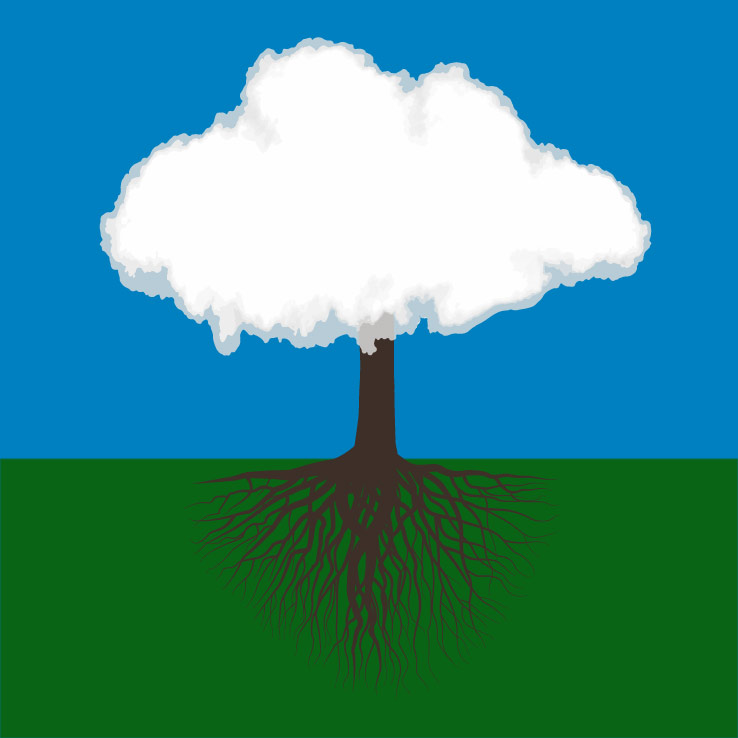The Clouds and Roots Model of Strategy

Understanding a Common Failure in Creative and Strategic Work
Please allow me to tell you a story, one which has been repeated time and time and time again in some of the most respected companies and creative agencies in the world; unfortunately, it is also a central weakness in sustainability as it exists today.
Far too often, in a campaign brief, business case, or frankly any strategic document, people enjoy hearing themselves speak. These words may be anything from the elaborate strategic designs of a visionary creative director, to the fevered attempts of a manager to make a mundane product launch plan seem interesting. Regardless of the cause, for some reason, strategy brings out a certain overstated, semi-Shakespearian manner of speaking in those writing the brief.
These presentations tend to go something like this:
"We seek. We strive. We live. People every day are looking for something. Searching for something they are missing. Searching for a piece of themselves. It happens to us all. It defines the human condition.
In our campaign, we will fill this deep yearning in our customers' lives. We will craft a physical tether–a link–representative of their connections to their family AND their possessions. Possessions which help them reach their family. We will blanket them in the comfort and security of being able to find keys and live their lives without uncertainty.
Behold: KeySeekr. The yellowest keychain in the world.
We will build the yellow color of our KeySeekr high-visibility keychain into the next Tiffany Blue. The campaign will secure our position in the lives of key-minded individuals and create an unbreakable bond of trust and an indelible mark on their lives. In our "Secure Yellow" campaign, we will show people that they will find the key to happiness... and it will be on a KeySeekr keychain."
Vision is an essential component of innovation and any new effort, and it is always a struggle to keep the vision alive. Perhaps the KeySeekr product and campaign may indeed deliver on those lofty goals. It is not ours to judge, but to understand. There may be, in fact, reams of research and insight work the KeySeekr team undertook that led them to this campaign platform (alternatively, not).
Regardless of the product or campaign, what we need to understand is how that vision will make its way into the actual customer experience: campaign messages and tactics, design cues, interactions, store atmospherics. And then, without any biasing influence or priming, we want to hear customers reflecting.
There are two thoughts to always keep in mind:
Everything sounds good in a brief. Everything.
It all means nothing until the strategy is reflected in tangible outputs, and furthermore, until we can test with customers. Many times, it may actually be beneficial to not even hear the brief so that you can interpret in an unbiased way.
How This Strategic Failure Presents Itself in Sustainability-Driven Innovation
Sustainability, by its very nature and intent, is highly aspirational. There aren't too many fields where the crux of your job is to 'make things better for the community and workers, the planet, and our company.' Similarly, when we seek to create truly sustainability-driven innovations, much of the same aspiration and good intentions are at play, as well... we are seeking to create offerings that make the world a better place while allowing us to provide for ourselves and our families.
But. The stronger the aspiration and vision is, the higher the potential to be disconnected from various stark realities:
- Perhaps the strategy is beautiful and relevant and the product delivers, but it costs 4000% more than similar products while delivering marginal sustainability benefit.
- Perhaps the deeply aspirational goals of your program are not shared by the overwhelming majority of customers.
- Perhaps the sustainable vision of the team is not yet feasible given current technological constraints.
These stark realities come in a wide range of forms in sustainability, and this is why our critical analysis is so important: so that we may see if an organization is truly delivering on an especially set of goals, or if it is simply a veneer of good copywriting and design.
A Mechanism to Visualize and Map these Strategic Failures
The Clouds and Roots Model is intended to help us take those lofty aspirations and anchor them in the realistic and tactical experiential cues of our offering or program. What is interesting is that with some practice, you may find that this model can be applied to virtually any creative challenge... from logo design to redesigning a room in your home. It is indeed that flexible.
This may all sound a bit esoteric at the moment, but I promise it will not only make sense as we use it, but that we will use this model in very tangible, practical ways as we create and test offerings.

In any case, we can map continuity in strategy by linking three elements:
The Clouds: The aspirational and emotional end benefits we seek to create.
- This may directly tie to the Vision, Mission, and Values of the program, the emotional experience we want the customer to have from our offering, or the aspiration for the brand.
- Regardless of the intent, the cloud is about big ideas. Things we are passionate about as an organization or as people.
- Much of the aspiration we feel in sustainability can be located here... the ideas around making the world better, and 'doing well by doing good.'
- In many cases, the Clouds tend to be neglected or poorly defined because we tend to focus on executional details and creating 'what's in the box.'
The Trunk: The unifying theme or idea.
- The trunk is the idea that brings it together. The central theme. The first idea you want people to say when describing the offering.
- This may be a theme which is used only internally at the organization, or a customer-facing tagline.
- It acts as a path for perception, if you will. It is clearly defined in the middle, but diffuses at each end. This allows room for people - customers - to interpret and enrich with their own interpretations.
- Like a tree, the strongest campaigns have a single, straight, direct "trunk." You may have variations or riffs or extensions, but the goal is that everything anchors back into the main theme.
- In reality, the trunk is the most difficult to create, but the most beneficial. It can be difficult to select just one central theme or idea on which to execute.
The Roots: The tangible and tactical design cues, messages, and other experiential details.
- This is what the customer will actually experience, from store atmospherics to product packaging to service features.
- Just as in root systems, there could be hundreds, if not thousands, of experiential details if you get very granular. Every one creates meaning and provides "nourishment" to the vision.
- Ironically, in actual fieldwork and research, the most granular or "gritty" details are those which impress people the most.
Just as a brief example and to show some versatility, let's imagine we wanted to create a strategy for the first two minutes of a customer's experience at a nature-oriented spa.
Clouds - These high-level thoughts and feelings could include peace, tranquility, connectedness, separation from the "real world," safety, physical and emotional comfort, relaxation.
Trunk - "Be isolated together in a natural space." When many nature lovers speak of their most cherished - and relaxing experiences outdoors, they had a common theme of intense isolation, and yet, strong connection to themselves and their partner.
Roots - Water threshold entry, remove shoes before entry. Heated and cooled surfaces. "messy" materials like sand, pebbles. Scent design. No computers. Limited bookings and partitioned entry to provide continuous feeling of isolation. Location and siting to fit.
Then comes the true test of the strategy: live testing with real people. This is where virtually all organizations stop short... and why so many strategies fail. The elegant strategy that seemed so perfect in the meeting room is interpreted in completely unintended or unexpected ways by customers.
Through beta testing and consumer research, we will attempt to directly overlay customers' perceptions onto the model we create. In an unbiasing way, we will show a group of customers our offering in beta form and understand how they "redraw" the model. They may spontaneously share stories and feedback that directly tie to the intended emotional outcomes, they may perceive the product as having absolutely no tie to what we believed was the central idea, they may not understand the campaign at a basic level.
Our work is to continue to refine until the research shows that customers are, without our bias or influence, perceiving the offering as intended... and if it is a compelling proposition for them.
